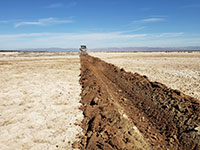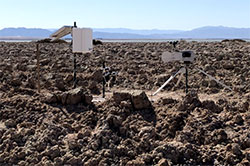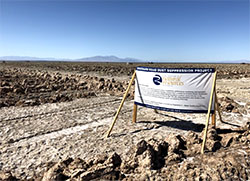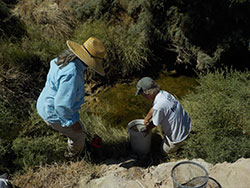Salton Sea, Riverside and Imperial Counties.

Surface roughening at Salton Sea.

Monitoring equipment.

Dust suppression at Salton Sea.

Fishery biologists Sharon Keeney of CDFW (r) and Shauna Bishop of Barrett's Biological Surveys look for desert pupfish.
Stretching between Southern California’s Imperial and Coachella valleys, the Salton Sea is what one might call a landmark of untraditional beauty. At 33 miles long and 5 miles wide, it’s the state’s largest inland lake, serving a crucial role as a stopover for migratory birds using the Pacific Flyway.
But the Salton Sea lacks the conventional, inviting atmosphere of other lakes on the West Coast. Its waters are rapidly evaporating, leaving another few thousand acres of dry and dusty lakebed (playa) each year. That loss of water increases the lake’s already-high levels of salinity, and it occasionally emits a pungent rotten egg odor that permeates the air. And – of particular concern to scientists – the evaporation decreases habitat for the wildlife that has historically thrived in and around this important ecosystem.
“Since its formation, the Salton Sea has been fed by irrigation runoff in the Imperial and Coachella valleys and inflow from rivers,” explained CDFW’s Salton Sea Program Manager Gail Sevrens. “But water transfers and related agreements and measures have contributed to a reduced volume of runoff, and as the water evaporates, the Sea has lowered in elevation. This has led to a shrinking, saltier Sea, and those increased areas of exposed dry lakebed can emit dust, which is of concern to local communities.”
Sevrens oversees CDFW’s participation in the Salton Sea Management Program (SSMP), which seeks to address those concerns, both for the benefit of fish and wildlife and the humans that live in the valley. The SSMP is an effort between CDFW and the California Department of Water Resources, under the direction of the California Natural Resources Agency. The partners seek to implement projects that will slow the damage and aid in recovery, primarily through the construction of approximately 30,000 acres of habitat and dust suppression projects around the Sea.
The program has several priorities:
- Making significant, visible progress in getting restoration and dust suppression projects accomplished as part of its 10-Year Plan;
- Creating a long-term plan;
- Building the team; and
- Strengthening local partnerships.
Many Californians are unfamiliar with how the current Salton Sea came to existence – it’s not an exaggeration to call this an “accidental lake.” Though large seas have formed and dried here throughout history due to natural flooding from the Colorado River, the Salton Sea in its current iteration was born in 1905 when the Colorado River breached an irrigation canal being constructed in the Imperial Valley. The escaping water slowly filled a dry lakebed nearly 300 feet below sea level. At first, developers imagined the Sea as a popular lakeside resort. But it was not to last, as without a continued, reliable source of water supply, the lake’s waters could only evaporate, reducing conditions for wildlife and nearby residents. In fact, due to agricultural runoff and evaporation, the water in the Salton Sea is approximately twice as salty as ocean water.
This fall, work began on the nearly 4,000-acre Species Conservation Habitat (SCH) project. That work will create a series of ponds at the southern end of the Sea that will include nesting and roosting islands and areas of varying water depths to serve as fish and bird habitat. At its healthiest, the Salton Sea was host to a half dozen species of fish, while 400 species of birds visited the lake while traversing the Pacific Flyway.
The SSMP projects provide dust suppression benefits. For example, temporary dust suppression measures have been taken on the south side of the Sea at the SCH site, where, through a process called surface roughening, approximately 700 acres of land were manipulated to create ridges and furrows that are perpendicular to the prevailing wind direction. Additional dust suppression and habitat restoration projects are in development for areas of exposed dry lakebed around the Salton Sea.
According to CDFW Environmental Scientist Samantha Przeklasa, the seemingly simple approach of rearranging the ground can make an enormous difference. “When the wind comes across the surface-roughening furrows, they slow the wind and catch particulate matter in the air. That matter gets caught in the little furrows, in the low spots.
(Watch this  video tour of the Salton Sea with Environmental Scientist Samantha Przeklasa)
video tour of the Salton Sea with Environmental Scientist Samantha Przeklasa)
Though habitat work is just beginning, scientists are seeing the benefits for one species already. Przeklasa praises fellow CDFW Environmental Scientist Sharon Keeney for her work finding, relocating and ultimately saving desert pupfish. The only native fish species at the Salton Sea, the tiny pupfish are found in shoreline pools, agricultural drains and natural creeks. Though pupfish can survive low levels of dissolved oxygen, high salinity and high water temperatures, they won’t survive in ponds and ditches that go dry. That’s where Keeney’s work has truly made a difference.
“There are many irrigation drains across the entire Salton Sea, on the north and south. Sharon spends a lot of her time monitoring those drains to see where the pupfish are thriving, and then rescues them from small drains that may be about to completely dry up,” said Przeklasa. “From a small pond, we can get hundreds, if not thousands, of fish out of it.” The fish are relocated to nearby ponds that are fed by natural desert springs, or managed ponds. Desert pupfish have also been relocated to ponds at a local high school, UC Riverside’s Palm Desert campus, and the Living Desert Zoo and Gardens in Palm Desert. The latter has even named one of its newest desert pupfish refuge ponds after Keeney.
Ultimately it will be engineering and habitat construction that helps the pupfish and other species survive. The work being done brings joy to program manager Sevrens, who was first attracted to the unusual beauty of the Salton Sea through documentaries. Her affection for the lake grew even further while bird-watching and occasionally kayaking there.
“A lot needs to go on behind the scenes before you can actually do a project, and we are moving forward on multiple project tracks at a time,” she said. “It’s exciting to see the pieces coming together.”
###
Media Contact:
Tim Daly, CDFW Communications, (916) 201-2958
CDFW Photos